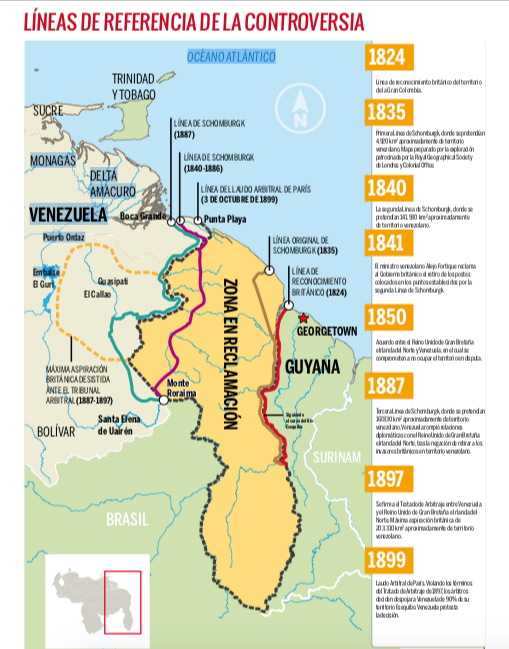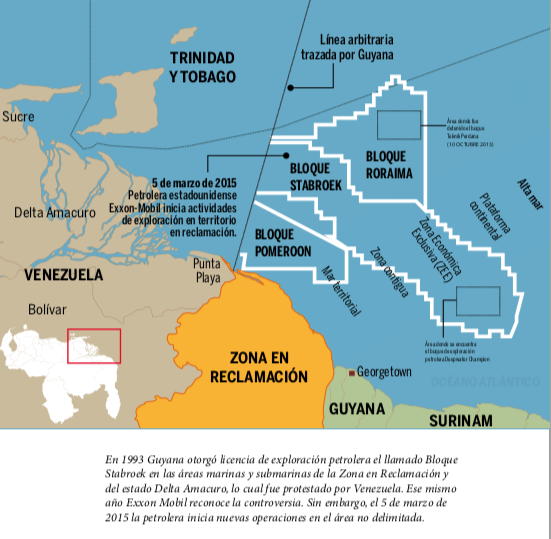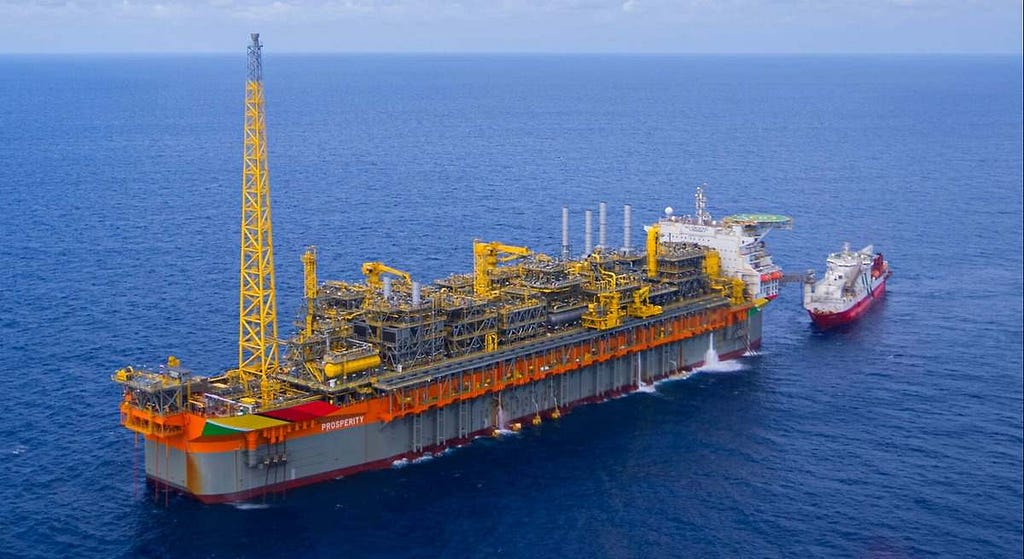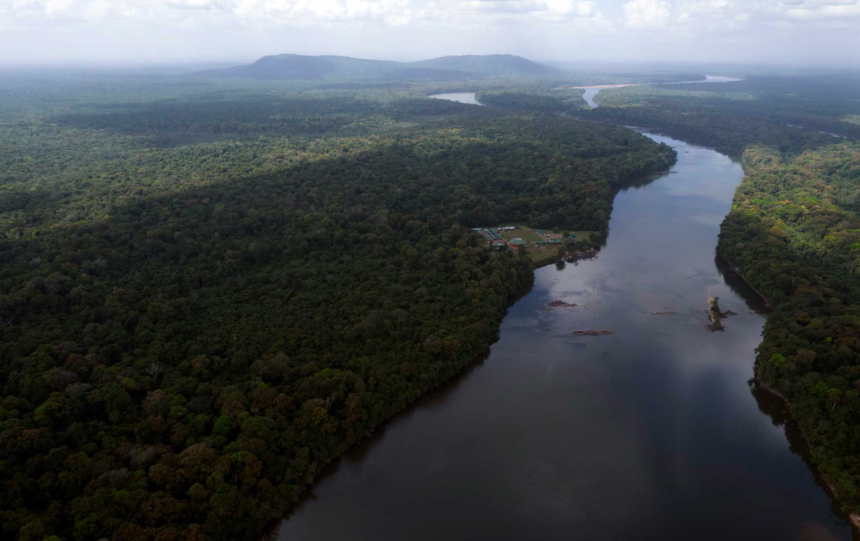Another fight over oil. Venezuela against Guyana. The big fish wants to eat the small one because of his resources.
The oil industry, despite being condemned by the environmental sectors of society, continues to advance in an attempt to recover oil from where it was previously impossible. Technologies advance, and it is now possible to extract oil where it was not possible before.
It’s unheard of. With the climate problem that the world has due to the consumption of fossil fuels, oil companies continue searching for oil, and every time they find it, they generate a new conflict that confronts several countries. Now it’s Guyana’s turn. What Latin America was missing was a war between Venezuela, Guyana and who knows who else, (in addition to Exxon Mobil, an American company that exploits the deposits, is also involved in this mess, and with it the United States), over some oil wells.
Guyana is one of the poorest countries in South America, and is experiencing a revolution since reserves equivalent to more than 11,000 million barrels of oil were discovered. Guyana has 800,000 inhabitants, and has a border with Venezuela, a much larger country, with which it has had a dispute over its sovereignty since 1841.
Although the Venezuelan claim has persisted throughout this time, the government of President Nicolás Maduro has progressively raised its voice since 2015, when the vast oil deposits were discovered in the area that Venezuela wants to make its own. The big fish wants to eat the small one.
The Venezuelan Foreign Minister, Yván Gil, published on his social network account “Venezuela expresses its categorical rejection of the announcement by the Government of Guyana, regarding the start of oil production by the Floating Production, Storage and Offloading Platform FPSO Prosperity, in the Payara field, located in a maritime area pending to be delimited. “, said the official in his post.
This action, the letter indicates, contradicts public international law and “constitutes a new provocation by a government at the service of Exxon Mobil,” the first and largest oil producer in Guyana.
In Guyana, the oil company Exxon is using floating mastodons that are a kind of ship, tank and oil platform (all at the same time) that are being of great benefit to extract every last drop of crude oil under the sea. Guyana’s GDP per capita has tripled since 2019 according to World Bank and IMF data and projections. But most of the reserves are located in a 26,000 square kilometer oil and gas block known as Stabroek, off the country’s Atlantic coast.
Guyana has gone from producing virtually no barrels of oil in 2019 to reaching 300,000 barrels per day this year. Furthermore, something very characteristic of the Guyanese oil industry is that all that oil is extracted in ultra-deep waters, so specific machinery, logistics and technology are needed for its extraction. Precisely, this month of November a very relevant event has occurred: production work on the floating production, storage and unloading vessel, called Prosperity, has begun.
The vice president of Guyana, Bharrat Jagdeo, announced at the end of April the approval of the exploitation of the Uaru field, in deep waters of the country, which will produce 250,000 barrels of oil per day in 2025. “Venezuela has demonstrated this illegality of prospecting and of the extraction — in a documentary manner — and repeatedly communicated to the Guyanese Government and the Caribbean community that such actions are becoming the greatest focus of destabilization in the region, undermining the legitimate interests of the Venezuelan people,” continues the statement released in networks.
For its part, the oil company Exxon Mobil has already begun extracting oil in Payara, the third largest producing field of this fuel in Guyana, with the intention of producing about 620,000 barrels per day.
What is the territory in dispute?
Venezuela and Guyana are experiencing an escalation of tension due to the dispute over the Essequibo territory. With 160 km², the enclave located on the border between both countries has been the subject of dispute since the 19th century, but the case became complicated in 2015, after the discovery of enormous maritime oil reserves in the region.
The Guyana government handed over the exploration concessions to the multinational Exxon Mobil, which displeased Caracas, since the region is in dispute and the decision was made unilaterally.
In 2018, Georgetown decided to take the case to the International Court of Justice (ICJ) — a UN tribunal based in The Hague -, a decision challenged by Venezuela, which alleges the Geneva Agreement, signed in 1966, as the only valid document. to resolve. the fight. In recent months, countries have raised their voices after Caracas announced the holding of a referendum to seek popular support for their demands. The vote is scheduled for December 3 and will ask voters if they agree, for example, not to recognize the ICJ to judge the case and create a new Venezuelan state in the disputed territory.
The participation of the Venezuelan Armed Forces in the referendum campaign generated condemnation from the Guyana government, which went so far as to say in The Hague that the vote represents “an existential threat” to the country.
Venezuela condemns the joint military exercises carried out by the Guyanese and US armies on the border and Washington’s promises to “strengthen the defense” of the country against “transverse threats.”
The 800 kilometer border between Guyana and Venezuela is mostly impenetrable jungle. And the second claims about two-thirds of Guyanese territory, in a dispute that was reactivated in recent years after the discovery of crude oil and gas near the maritime border between both countries.
Current status of the dispute
On December 3, the National Electoral Council of Venezuela set a referendum on “the rights” in the disputed territory, after receiving the proposal from the National Assembly. Both countries have been involved in a long-running dispute over their borders. Caracas recognizes as the only legal instrument to resolve this controversy the Geneva Agreement, signed in 1966 with the United Kingdom (before Guyanese independence), and which establishes bases for a negotiated solution, but those negotiations lasted for more than two decades without results. , so Guyana seeks a solution through the International Court of Justice (ICJ).
The ICJ ruled that it had jurisdiction over the issue, which could determine which country has rights to oil and gas-rich territories, especially offshore.
The Minister of Foreign Affairs, Mauro Vieira, defended this Wednesday (22) that the border dispute between Venezuela and Guyana over the territory of Essequibo be resolved through dialogue. And in this, Brazil comes in to mediate in the conflict, and the United States in support of Guyana, in case Maduro makes a mistake where he shouldn’t, “Brazil called, with all other countries, for understanding, for diplomatic and peaceful resolution of disputes. I had the opportunity to say that Brazil defends negotiations, understandings and arbitration, with appeals to international courts, such as the Hague Court. , whenever possible,” said the chancellor. The statements came after a meeting between foreign ministers and defense ministers of South American countries that took place in Brasilia.
Representing Caracas, the Minister of Foreign Affairs, Yván Gil, and the Vice Minister of Defense, Félix Osorio, were present at the meeting. Guyana sent Prime Minister Mark Phillips, second in line to President Irfaan Ali. According to Vieira, “both the Guyanese and Venezuelan delegations expressed their opinions and positions on the conflict, on the territorial dispute they have and which has been discussed in a bilateral process for at least 120 years.”
“I think it was an important moment for the two countries to present their positions, for them to be heard by everyone and for them to have had the opportunity to listen to this demonstration from Brazil,” said the minister.
Through social networks, the Venezuelan foreign minister spread excerpts from his speeches during the summit in which he accused Guyana of planning a “warlike aggression” against Venezuela. “We draw attention to Guyana’s obfuscated position of incorporating external actors, such as the United States, in the Essequibo territorial dispute, with the presence and joint military actions of the Southern Command to threaten our country and design military aggression plans against our will. . To do this, they intend to install military bases in the territory that is the subject of controversy and these actions are simply unacceptable,” he stated.
The minister also reiterated Caracas’ position of adhering to the Geneva Agreement to resolve the territorial dispute and said that the Guyanese government cannot “give illicit concessions in undelimited waters.” Guyana had not commented at the time of writing.
Once again the premise is fulfilled that opposing interests generate tensions, which trigger conflicts, which can end in wars. We’ll see where this one ends.
Sources: Guyana-Esequiba, historia de un despojo, Observatorio del Sur Global
El artículo se puede leer en español en este enlace.




Comments